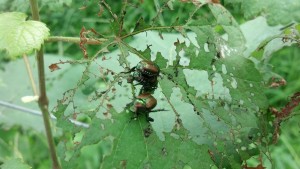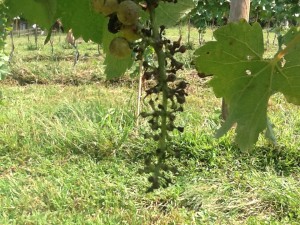Tag: Lucie Morton
A Tough Year for a Weekend Vintner
It was a tough year to be a weekend vintner.
When you’re separated from your vineyard by a two-hour drive, you have to make the most of your time. And we try. But the weekends are short, and there’s so much to do. And every curve that Mother Nature throws your way puts you just a little bit further behind. This year, Mother Nature was throwing curves, sliders, and the occasional spitball.
This year began with a late spring frost, followed by rain. Not just a little rain, but lots of rain, which gave rise to all kinds of fungal disease potential. Powdery Mildew, Downey Mildew, Botrytis, you name it.
And then came the pests: Japanese beetles, birds, raccoons, squirrels, deer, and even bears. Yes, indeed, bears. No lions or tigers,though. Just birds, deer and bears. And yeah, racooons and beetles and the rest of the pests.
That’s one of the reasons I’ve not been able to pay much attention to this blog. Another was that Chris and I took on responsibilities for editing Grape Press, the quarterly publication of the Virginia Vineyards Association. But mainly it was the challenges of the growing season. It seems like we spent all of our spare time each weekend keeping up with the vineyard. Spraying, cultivating, pruning, and spraying. Yeah, lots of spraying. It wasn’t easy.
Let’s start with the late frost. I remember arriving at the vineyard early one Saturday morning to find our whites all but devastated. Honestly, it looked as though someone had sprayed Round-Up and left them to die. For a while, I actually wondered if they had been the victims of spray drift from the herbicide we had used to clear a row for new the new vines we had planted this year.
Fortunately, that was not the case.
After checking the temperatures recorded nearby, I realized that we had probably experienced at least one and possibly two frost events in which temperatures had dropped just below freezing for a few hours in the early morning. My reds were fine, but they are planted higher on the slope and there’s a good possibility that temperatures stayed a degree or two higher in their part of the vineyard. Alternatively, bud break came earlier for the whites and they may have just been victims of bad timing. I’ll never know.
It turned out okay, though. Both the Petit Manseng and the Viognier had enough secondary buds left to generate growth for this year. Within a few weeks, we were seeing buds break and shoots begin to develop. And by the middle of the summer, they were looking like grape vines again. So, all was well.
But then it started to rain. Continue Reading–>
Where Did the Grapes Go?
Five days ago, at the end of the holiday weekend, I was thrilled with the progress of our vines. We hadn’t allowed a lot of grapes to accumulate, given that the vines were only in their second year, but we had left a few clusters, and they looked beautiful. Moreover, they tasted amazingly sweet.
Alas, last weekend I had left my refractometer at the other house, and so I couldn’t measure the Brix, which would have told me how much sugar had accumulated in the grapes and therefore the potential alcohol. Not essential, given that we weren’t planning to make wine from this grapes, but it would have been nice to know. But I told myself, it’s Monday, I’ll be back on Friday, and I’ll be able to measure the Brix on Saturday morning. What could go wrong with that?
Well, of course, lots of things could go wrong. But what I wasn’t expecting when I returned this weekend was to find the grapes gone. Yes, gone. As in, missing. As in, virtually none of them left on the vine.
It turns out I was right about one thing. The grapes had ripened and accumulated a decent amount of sugar. Which meant that they were not only close to being ready for the crush, they had become attractive to lots of the critters that roam through the country near our vineyard. Birds, deer, badgers – who knows? Almost any animal cruising near our property could have decided to chow down on our grapes.
So, a few lessons.
First, we didn’t lose quite all the grapes. I had put bird netting up around some of the Cab Franc vines a few weeks before, and those grapes were largely intact. I measured the Brix and it came in at about 21.2 percent. Not bad. Not quite ready for the crush pad, but getting there. It’s been a horrible year with the rain and dark skies, but another week or two in the sun (assuming we get a week or two of sun) and they might have made pretty decent wine.
Second, among the grapes we didn’t lose were those in the “mother vineyard.” These are the Cab Franc vines we had planted in the first year before we even knew where the main vineyard would be located. We had purchased them for practice and never even really considered that we’d use them for wine. These, the critters left alone.
But why? Well, when I measured the Brix it was at about 16 percent. Not even remotely ripe enough for wine. So maybe these grapes were ignored because they weren’t sweet enough. Apparently the critters that hang around our property are pretty choosy in what they bite off. Continue Reading–>





Recent Comments